The Best Chef’s Knife
Welcome to F&W Gear Guides. We publish buyer’s guides to essential pieces of kitchen gear based on real-world testing. Missed an installment? Find them all here.
After researching popular models and consulting the author of an excellent new book on kitchen cutlery, we tested 14 highly-rated chef’s knives by chopping, slicing and dicing a variety of foods over the course of two weeks. In the end, we loved six knives: A razor-keen all-rounder that can handle any job, two classic workhorses that are excellent for tough tasks, a scalpel-sharp tool for those demanding surgical precision, a wonderful featherweight kitchen knife and a best-value pick.
Our top picks:
Best Overall: MAC MTH-80 Professional Series 8-inch Chef’s Knife with Dimples (available at amazon.com)
Best Tough Workhorses: Wüsthof Classic 8-inch Cook’s Knife (available at amazon.com) and J.A. Henckels International Classic 8-inch Chef's Knife (available at amazon.com)
Best if You Live Near a Good Sharpener: Misono UX10 Gyutou (available at amazon.com)
Best Lightweight: Global G-2 Classic 8-inch Chef’s Knife (available at amazon.com)
Best Value: Mercer Culinary Renaissance 8-Inch Forged Chef's Knife (available at amazon.com)
Read on to learn what makes a great chef’s knife, and our detailed reviews of each knife.
RELATED: The Best Knife Sets on Amazon
In Search of the Best Chef’s Knife
A knife is probably the only kitchen tool you must use every single time you prepare food. Even a stove can be optional—you can do without it to make a salad, say, or tartare, but a good chef’s knife is indispensable. Humans’ reliance on knives goes way, way back—some scientists say that what really made us human was the moment when, about two and a half million years ago, some pre-human ancestor used a crude stone blade to cut up a carcass. The ability to cut up meat, share it, store it and carry it, allowed us to consume more calories and to relate to each other differently. Our brains got bigger, our jaws got smaller, our tools got more sophisticated and our cooperation improved—the whole progression of human history sparked by the knife. And all of it leading to you, standing in Williams Sonoma, debating between a Wüsthof and a Global.
Related: The Best Knife Sharpeners
There is no such thing as the best chef’s knife—finding the knife that works best for you involves considering many variables, like the size of your hands, the style of your cooking and what feels natural and comfortable to you. For the purposes of this story, I limited the testing to eight-inch, Western-style or hybrid Japanese-Western chef’s knives with a list price under $200, though most cost significantly less than that.
Loosely, two attributes characterize a Western or hybrid style chef’s knife. First, the belly of the blade is more or less curved, so that you can use the rocking chopping motion—in which the tip of the knife doesn’t leave the cutting board—that’s common in Western kitchens. And second, the blade edge is beveled on both sides, creating a cutting edge shaped like a “v,” rather than beveled on only one side, as is traditional for some Japanese knives.
A Word on Steel
The much-simplified big picture is that if you are looking for an all-purpose 8-inch chef’s knife—one that’s in a reasonable price range and carried by most retailers—you have a choice between heavy duty, German-style models (like Wüsthof), which are usually made with slightly softer steel alloys (“alloy” just means a mix of different metals), or lighter Japanese-style models (like Shun), which are usually made with harder steel alloys. Neither is necessarily better than the other. They are just different, especially in terms of the way they feel and move in your hand.
A harder steel holds a sharper edge for a longer period of time, but can be more difficult to sharpen once it does get dull. And a very hard, very sharp edge can also be more delicate and brittle than a softer one, making cutting up a heavy squash, say, a little risky to the blade. (However, a knifemaker can mitigate that brittleness by adding another element to the mix: Molybdenum, for instance, is often used to give a very hard steel more flexibility.) A softer steel alloy, like those used in the German tradition, may be less sharp to begin with and get dull a little faster. But it can be easier to re-sharpen, and better for heavier-duty jobs, like splitting bone-in chicken breasts, without worry that you’re going to damage the blade. Speaking very generally, a harder steel is sharper and more delicate, while a softer steel is tougher. If you’re shopping for a knife, you can ask where it falls on the Rockwell Hardness Scale. Low to mid 50s is on the softer end, mid-50s to low 60s is hard.
“If you are going to the Antarctic tomorrow, and you can only bring one knife, get a German eight-inch chef’s knife” says Tim Hayward, chef and author of the newly released book, Knife: The Culture, Craft and Cult of the Cook’s Knife. “For everyone else, I have no way of knowing if you prefer heavy or light, a deeper throat, a special blade, something bigger. It’s intensely personal. A little emotional. A little experiential.”
Hayward’s advice? Bring a bag of overripe tomatoes with you to the knife store. “If they won’t let you test the knives, walk right out,” he says. “You won’t really know which knife you like best until you use it to slice an overripe tomato.”
The Tests
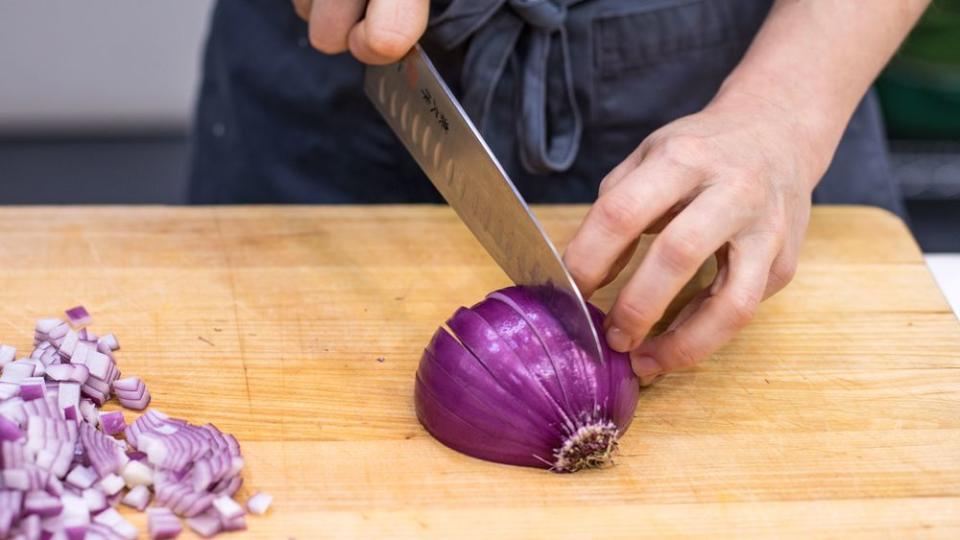
All that being said, it’s quite possible to narrow down the field first, to help you identify a knife that might be best for you. I tested 14 knives over the course of two weeks. I used them in the normal course of my daily cooking, just to get to know them, and I also tested them in six important tasks: dicing an onion, slicing basil into chiffonade, slicing tomatoes, cubing butternut squash, supreming an orange and cutting up a whole chicken. (Though I used kitchen shears to cut through the chicken ribs to separate the breast from the back, as no chef’s knife is really meant to cut through bone, only through joints and cartilage.) Those tasks tell you almost everything you need to know about whether a knife is nimble and sharp, sturdy and powerful, and above all, comfortable and secure-feeling.
The knives ranged from $38 to about $200, and I found that price isn’t necessarily commensurate with quality and performance, though the very best knives are not cheap. They ranged in weight from 5.8 ounces to 9.95 ounces, and there were winners and losers on both ends of the weight spectrum.
A note on keeping your knives sharp: You can buy the best knife there is, but eventually you will need to sharpen it or it will be useless. (Honing a knife on a ceramic rod is not the same as sharpening; honing will smooth and maintain the blade between sharpenings.) Home cooks can bring the knife to a professional, or can buy a simple, plastic wheel grinder, which makes sharpening cheap, fast and foolproof. (Like this one, which works for most chef’s knives, though it is recommended for MAC.) Hayward says that he likes to relax at night with a glass of wine and a whetstone and painstakingly sharpen his hundreds of knives. But, take his advice: “If you want a life, you want a wheel grinder,” he said. “You’ll have the sharpest knife on the block and still have time to play with your kids.”
The Best Chef’s Knives
Best Overall: MAC MTH-80 Professional Series 8-inch Chef’s Knife with Dimples (available at amazon.com)
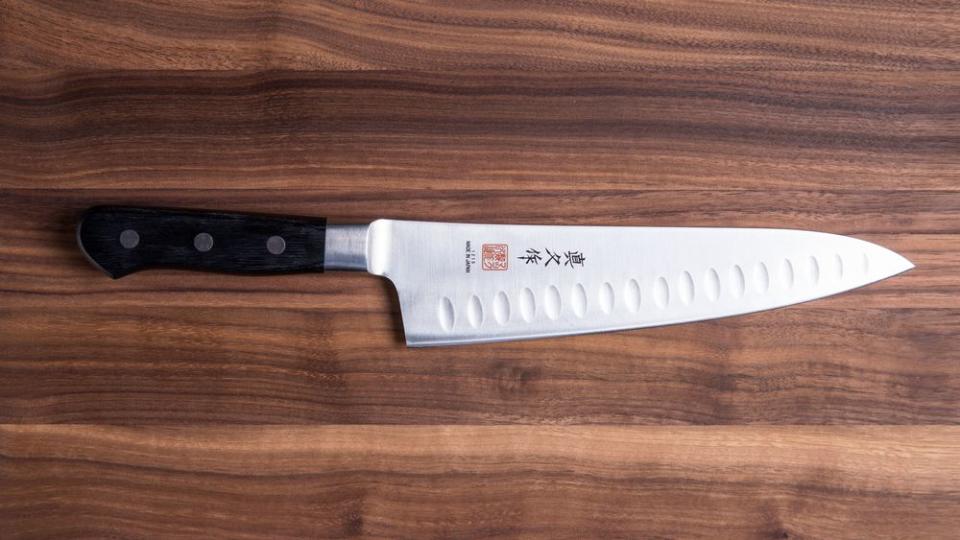
Hayward calls this knife a “terrific all-rounder,” and I agree. Made in Japan, it has a hard, super-sharp blade and a simple wooden handle that’s extremely comfortable and feels secure in the hand. It’s razor sharp for a reason—MAC’s founder modeled the company’s knives on razors. The blade is beveled to a very thin, very acute angle, which makes it extraordinarily sharp. The the high carbon stainless steel makes it quite hard, but also has a dose of molybdenum, which lessens brittleness and makes the metal more flexible, less likely to chip. It’s light and feels balanced, with a shape that’s natural and easy to control. It can chiffonade basil cleanly, without bruising the leaves at all. It effortlessly bites through tomato skin, and cuts a neat onion dice with ease. It supremes an orange quickly and precisely. The combination of the razor-like blade and the familiar, comfortable blade shape and handle were, for me, what made it the very best choice overall. It is on the light side, but not the lightest of the light: It is less well suited to cutting up a whole chicken or butternut squash than the German knives, but it was the best Japanese knife for those tasks, with just enough heft to get the job done. If I could only have one knife, I would definitely choose this one. (Weight: 6.8 ounces.)>
Best Tough Workhorses:
Wüsthof Classic 8-inch Cook’s Knife (available at amazon.com)
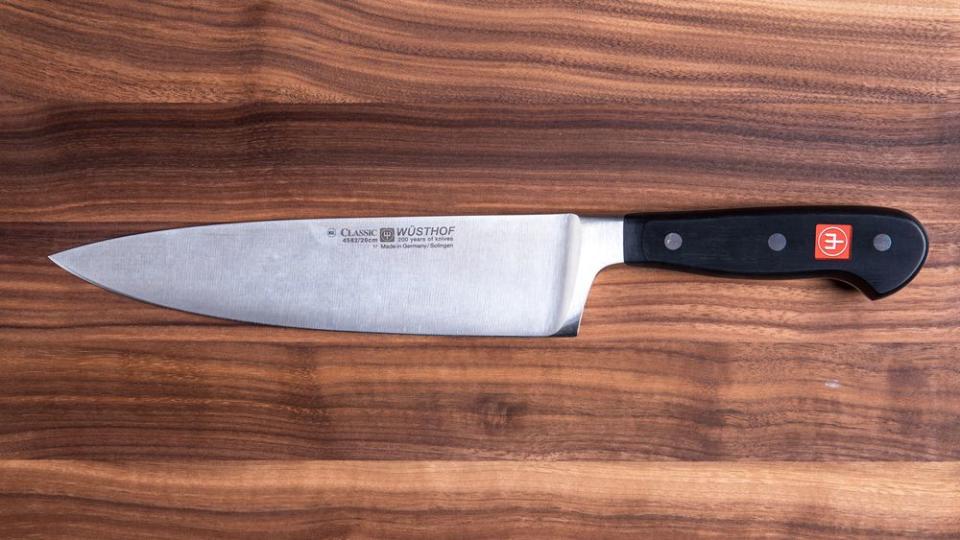
J.A. Henckels International Classic 8-inch Chef's Knife (available at amazon.com)
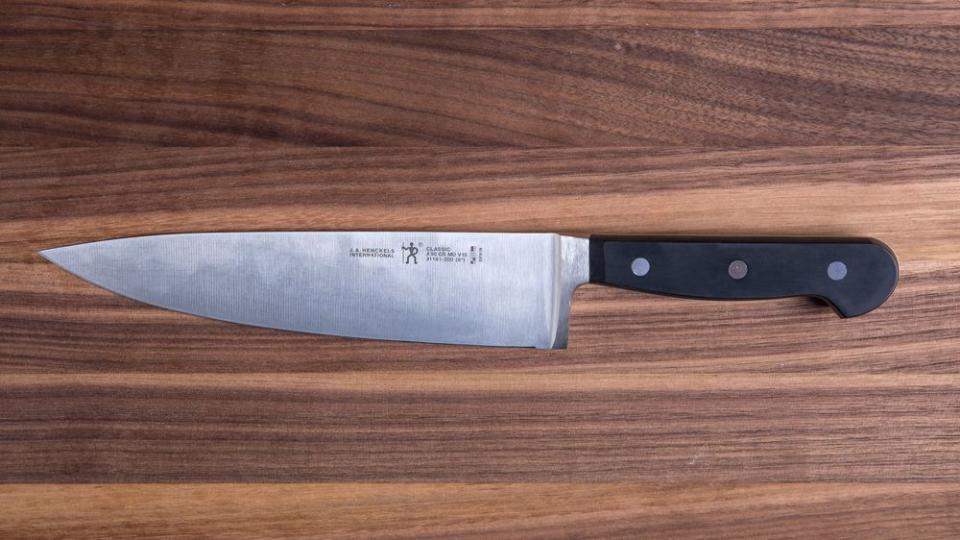
These are the indestructible German blades that Hayward would take to a desert island. Both are made of slightly softer steel than the best Japanese knives, and therefore they feel a little less sharp. They are heavy and powerful, less nimble than the lighter knives, but they are both excellent at cutting up a chicken (including cutting through the chicken breastbone to spit the breasts, which I was afraid to do with some of the sharper blades) and cubing butternut squash—far and away the best at those two tasks of all the knives I tested. If you cook big cuts of meat often, one of these is probably the best for you. And they are good all-around: There’s nothing they can’t do; it’s just that I find them less easy to work with, and for some tasks, less than ideal. For instance, when you chiffonade basil with either model, the delicate leaves get ever-so-slightly bruised on the edges from the thicker blades. I find the Wusthof is the more comfortable of the two—very secure and well-balanced in the hand—and the wide-bellied blade makes it a breeze to chop with a rocking motion. But these two models have so many similarities in style, design and performance, and such a difference in price, that it’s hard to recommend the Wüsthof over the Henckels. So we’ll call it a tie. (Weight: Wüsthof - 9.28 ounces, Henckels - 8.22 ounces.)
Best if You Live Near a Good Sharpener: Misono UX10 Gyutou (available at amazon.com)
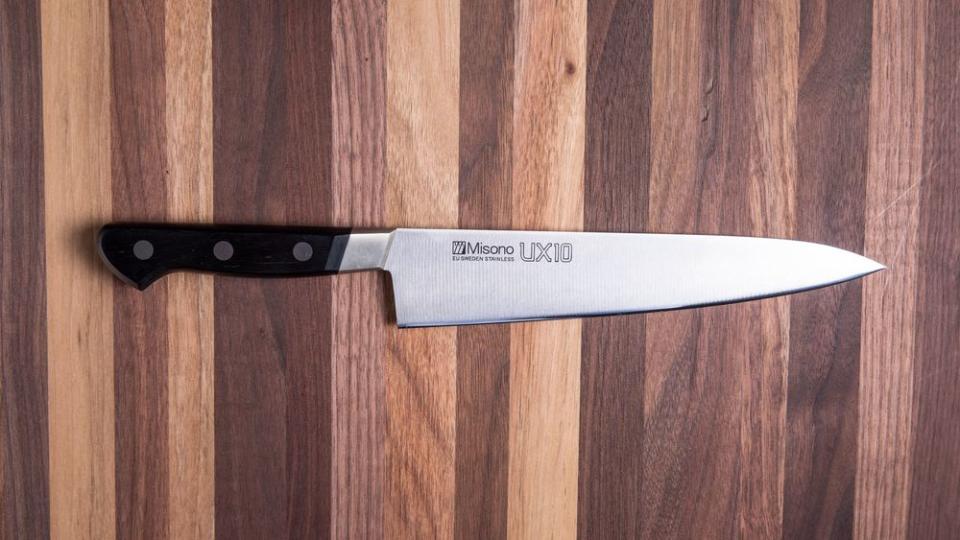
When you chiffonade basil with this knife, it feels like the leaves are springing off the blade in perfect ribbons all by themselves. This knife is a joy. “Like butter,” comes to mind over and over again. It feels almost alive in your hand, super light and extremely agile. It bites through tomatoes with ease and supremes an orange into perfectly clean, neat segments in a few seconds. However, unlike the MAC, which has just enough sturdiness to deal with a chicken and a butternut squash, this knife just doesn’t have the oomph for hefty jobs. It has a scalpel-like delicacy and when I used it to tackle big, tough ingredients, it felt wrong, even a little dangerous, and I worried I would damage the blade. It also requires professional sharpening: One of the secrets to this knife’s amazingness is the fact that it is honed to an asymmetrical edge—one side is 70 degrees and one is 30 degrees, so you have to buy a left-handed or a right-handed model. That’s fine, but it will need to be sharpened by someone who knows what they are doing in order to stay that way. Hayward calls it “a living hell” to keep it sharpened correctly. (But he also thinks it’s the best knife on this list if you have access to a pro sharpener.) If you run it through an at-home wheel sharpener, it will hone the blade to an even “v,” which is standard, and you will lose the knife’s distinct quality. So as much as I adore this knife, I can’t recommend it as an all-purpose blade. (Weight: 5.82 ounces.)
Best Lightweight: Global G-2 Classic 8-inch Chef’s Knife (available at amazon.com)
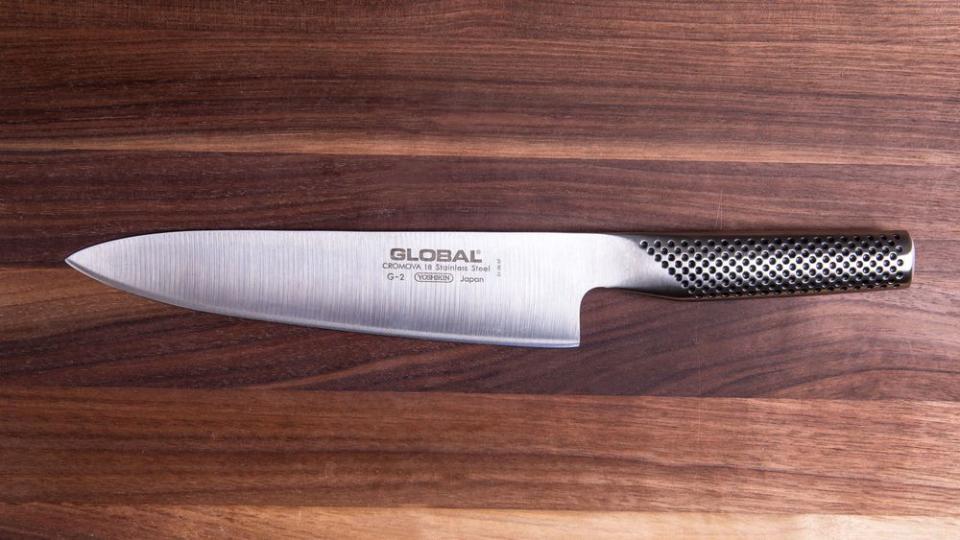
This was my first knife—I saved for it for months when I was in my early 20s, so I have a soft spot for it. (As with all the knives, I tested with a brand new version to keep all the variables consistent.) If you’re most comfortable with a very lightweight knife, and want one that’s easy to care for, this is the knife for you. It was the second-lightest knife I tested, only slightly heavier than the Misono, but it doesn’t require special knowledge to sharpen. It’s made of just one piece of metal, including the handle, which is hollow and filled with sand, which provides a subtle, shifting balance that you don’t really notice while you’re using it. The metal handle has dimples to provide the grip, and while some cooks think it gets slippery when used to cut chicken, meat or anything juicy, I haven’t found that to be the case. To me, it feels just right: Grippy, easy to control and very nimble. It excels at tasks like slicing tomatoes, chiffonading basil and dicing onion: It’s quite sharp and bites right through. Although it’s less well-suited to cutting up chicken or butternut squash, lacking the heft of the German models, with some extra care it can certainly get those jobs done. (Weight: 5.89 ounces.)
Best Value: Mercer Culinary Renaissance 8-Inch Forged Chef's Knife (available at amazon.com)
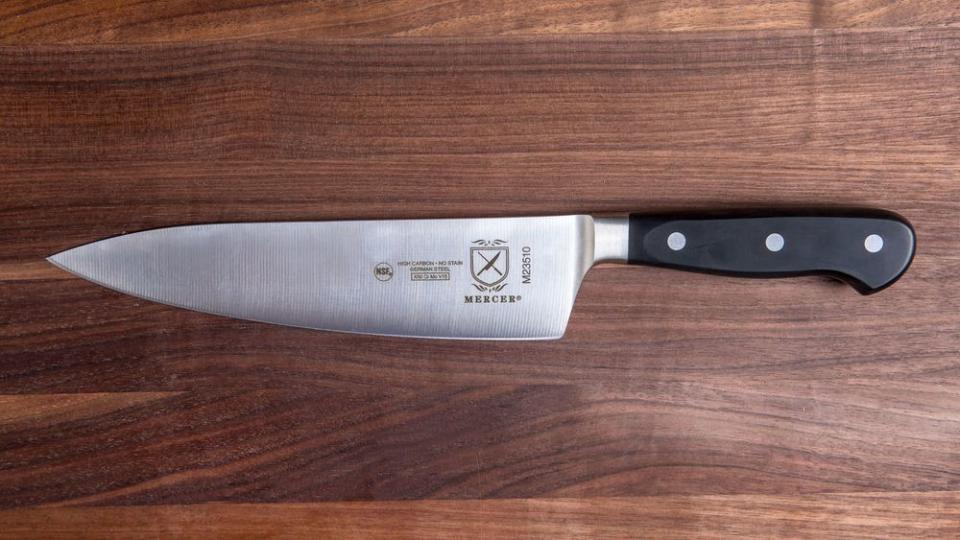
This is a terrific knife for the price. It’s in the hefty, powerful German style, made by a family-owned company in the United States. It ably handles just about anything you throw its way, though it’s a bit clunky in the hand and less-than-razor-sharp on delicate ingredients like basil, on which it leaves subtle bruises. It was one of the best of all the knives at cutting up chicken—giving Wüsthof a run for its money—but was also surprisingly adept at slicing tomatoes, supreming oranges and dicing onion. It has a simple, comfortable wooden handle without bells and whistles. (Weight: 8.32 ounces.)
Also Tested
Wusthof Classic Ikon 8-Inch Cook's Knife (available at amazon.com)
I like this knife very much, in all the same ways I like the Classic Wüsthof, but the main difference between the two is the Ikon’s contoured handle, which I find a little awkward. It’s also $20 more expensive. So though this knife is very handsome, I’d opt for the Classic for both price and comfort reasons. However, every hand is different, so if you have a chance to try it out, see if you find it more comfortable than the Classic—if you do, it would be worth the extra $20. (Weight: 9.7 ounces.)
Shun Sora 8-inch Chef’s Knife (available at amazon.com)
This is a scalpel-sharp knife with a very thin, nimble, extremely hard blade (about 61 on the Rockwell Hardness Scale) with a long, tapered tip. Like the other light, sharp Japanese knives, it did a fantastic job on everything but the chicken and the butternut squash, which, to be fair, it’s not really designed for. It’s also a fantastic value. I just couldn’t get over how the light, plastic handle felt—it’s not that it was uncomfortable, it’s more that it made my grip feel less confident. Again, especially when it comes to handles, your mileage may vary, so this knife might be worth a try. (Weight: 6.6 ounces.)
Miyabi Kaizen (available at amazon.com)
Another extremely sharp, hard blade, and one that I really liked. It had an effortless, precise way with onions, basil and oranges. I often found myself reaching for it when I wasn’t working—it rivaled (but didn’t surpass) the MAC and Misono for razor sharpness and spring. Although the blade’s performance was almost (but not quite!) comparable to the Misono, I didn’t find the handle comfortable or secure. It’s a long, thin grip that’s completely smooth, without any contour at all, and though it looks beautiful, it felt slippery and small in my hand. (Weight: 7.02 ounces.)
Zwilling Pro 8-inch Traditional Chef’s Knife (available at amazon.com)
Like the Wüsthof Ikon to the Wüsthof Classic, this is the more highly designed, costly sibling of the J.A. Henckels International. It’s a very nice knife, a classic, sturdy German blade with a deep belly that makes a rocking chop very comfortable. In terms of ease and performance, I found it comparable to the J.A. Henckels International, which is made by the same company but is quite a bit less expensive. If you are in the market for a heavy German knife, it may make sense to try them both. (Weight: 8.92 ounces)
Miyabi Evolution 8-Inch (available at amazon.com)
This is a really good knife, a Japanese-German hybrid, with a flat-sided wooden handle and a very sharp, very hard blade with a relatively wide, curved belly. It simply didn’t surpass other comparable knives in testing, particularly in quickly and easily dicing an onion and slicing tomatoes. It didn’t feel quite as sharp and precise as MAC and others. (Weight: 8 ounces.)
Bob Kramer Essential Collection 8-Inch Chef’s Knives by Zwilling J.A. Henckels (available at amazon.com)
Bob Kramer is one of the most important knife-makers in the United States—his handmade knives cost thousands and thousands of dollars and have long wait lists. Kramer licenced Zwilling J.A. Henckels to make knives for him in Japan—though it is a German company—and thus this line was born, a Bob Kramer knife that’s accessible for almost anyone. I loved the grippy, comfortable handle and the feeling of power that came from this heavy, wide blade. But oddly, it didn’t seem as sharp as the others, as it was a bit of a struggle to make a clean tomato slice. Dicing an onion, it felt balky and a little dull, almost hard to control. I wanted to like it because, of all the heavy knives, it was the most comfortable and balanced to hold, but it didn’t perform as well as I hoped. (Weight: 9.2 ounces.)
Victorinox 8-Inch Fibrox Pro Chef's Knife (available at amazon.com)
This knife tops many lists as a great value, but I found it to be the worst of the two worlds: light but not very sharp, cumbersome and large. It was reasonably sharp coming out of the box (though still on the dull side compared to most others on this list) but after couple of weeks of use, it was a struggle to slice a tomato or an onion. You shouldn’t need to sharpen a knife every two weeks. I also didn’t love the feel of the textured plastic grip. (Weight: 6.46 ounces.)
Messermeister Meridian Elite Chef's Knife, 8-Inch (available at amazon.com)
This was the heaviest knife I tested. It felt clunky and unwieldy, and worse, was dull right out of the box. It didn’t perform well on any test. (Weight: 9.95 ounces.)

